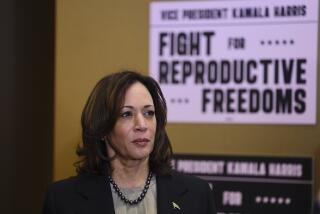Clinton Lifts Restrictions on Abortion : Health: President ends ban on fetal tissue research, overturns gag rule on counseling at clinics, clears way for the FDA to allow importing of French RU486 pill.
With a stroke of a pen, President Clinton marked the 20th anniversary of Roe vs. Wade on Friday by dismantling a series of Ronald Reagan and George Bush Administration abortion restrictions, only hours after tens of thousands of anti-abortion demonstrators rallied across the street from the White House.
“Our vision should be of an America where abortion is safe and legal but rare,” Clinton said, as, on his third day in office, he fulfilled a campaign promise to abortion rights supporters and medical research organizations.
By executive order, Clinton:
* Ended a five-year ban on fetal tissue research, which scientists believe holds the possibility of benefiting patients with Parkinson’s disease, Alzheimer’s disease, diabetes, Huntington’s disease, spinal cord injuries and other conditions.
* Overturned the so-called gag rule that restricted abortion counseling at 4,000 federally funded family planning clinics nationwide.
* Revoked prohibitions on the importation of RU486--known as the French “abortion pill”--for personal use, if the Food and Drug Administration determines that there is no justification for the prohibitions.
* Allowed abortions at U.S. military hospitals overseas, if they are paid for privately.
* Reversed a 1984 order which prevented the United States from providing foreign aid to overseas organizations that perform or promote abortion.
Abortion rights advocates said Clinton’s actions were nothing short of historic.
“In one day, no President has ever done more to affirm the right of women to make personal reproductive choices,” said Rep. Henry A. Waxman (D-Los Angeles), author of legislation, vetoed last year by Bush, that would have overturned the fetal tissue research ban.
His sentiments were echoed by Kate Michelman, president of the National Abortion Rights Action League, who said the steps “signal a dramatic and decisive shift in White House policy on a woman’s freedom to choose.”
“Today’s executive orders mark a triumphant beginning for President Clinton, who has swiftly and decisively fulfilled his vow to revoke dangerous Bush/Reagan anti-choice policies,” she said. But Wanda Franz, president of the National Right to Life Committee, expressed the deep disappointment of the anti-abortion movement. “President Clinton insults--on the day he declared “Fellowship Day”--the millions of pro-life Americans, whose views he recently claimed to respect,” she said.
Existing law prohibits the direct use of federal funds for abortion procedures, except to save the life of the woman. Clinton’s orders apparently do not violate those statutes, although they loosen previous interpretations of it.
His actions came as abortion opponents staged their annual march to mark the anniversary of the landmark 1973 Supreme Court case that established abortion as a right--one that is exercised by an estimated 1.6 million U.S. women a year.
Police estimated that 75,000 people, 5,000 more than last year, gathered for a pre-march rally across the street from the South Lawn. From there, they marched to the building that houses the Supreme Court.
In years past, Bush spoke to the group via an electronic hookup. This time, however, there was no encouragement from the White House.
For Marty Pressau, that was reason enough to stand on the muddy Ellipse, holding a placard displaying a graphic color photograph of a dismembered fetus. Although the 35-year-old bank auditor had participated in protests in Pittsburgh, Pa., it was the first time he had joined the national march in Washington.
“People are angry, very angry,” he said.
Carl Mohme, a 28-year-old computer programmer standing about 100 yards away, said he had been a member of one of 28 busloads of demonstrators to make the journey from St. Louis. “It is disappointing this year not to have a pro-life President, no doubt about it,” Mohme said. “We don’t have any false illusions about President Clinton, but it’s important that he hear us.”
In Orange County, both anti-abortion and abortion rights activists reacted strongly to the President’s actions.
“I am more than pleased that President Clinton has taken huge steps in promoting the rights of women and their ability to control their own fertility and, therefore, their lives,” said Barbara Jackson, director of public affairs for the Orange County chapter of Planned Parenthood.
“This is clearly a significant day,” Jackson added. “I feel that now we are going in the right direction.”
But Fountain Valley resident Beverly Cielnicky, president of the anti-abortion group Crusade for Life, criticized Clinton and said he should have left it up to Congress to dismantle the restrictions.
“Babies are being killed,” she said, “and that’s something this country has to come to grips with.”
Cielnicky was particularly critical of the President for ending the ban on fetal tissue research. “It speaks of Nazism,” she said. “It’s like saying these people are going to be killed anyway so let’s experiment with them.”
In a statement, Cardinal Roger M. Mahony of Los Angeles, chairman of the National Conference of Catholic Bishops’ Committee for Pro-Life Activities, said it was “particularly lamentable” that Clinton chose the day of the march to sign the executive orders.
“Today’s actions will galvanize those Americans, and countless others, to work even more vigorously for the day when all members of the human family are invited to enjoy life, fellowship and hope,” said Mahony, who participated in the march.
Mahony said Clinton had vowed during the campaign to reduce abortions, saying that they should be safe, legal and rare.
“But surely you cannot reduce abortion by promoting abortion as just another method of birth control,” the Cardinal said. “You cannot reduce abortion by fueling a market for the tiny dead bodies of unborn children. You cannot reduce abortion by exporting abortion to the poor in the Third World.”
Research using fetal tissue obtained through abortions had been opposed by both the Reagan and Bush Administrations, which argued that it would encourage more women to terminate their pregnancies. Douglas Johnson, legislative director of the National Right to Life Committee, described it as “harvesting unborn babies for spare parts.”
However, opponents of the fetal tissue ban argued that the issue was not about abortion, but about the freedom to conduct potentially life-saving research. Fetal tissue is especially adaptive to transplantation, and scientists hope that transplanted fetal cells will take over the functions of cells that have been destroyed or damaged.
The President said he was ultimately persuaded to lift the ban by the tragic personal stories of individual Americans.
As he signed the order, Clinton offered “a special word of personal thanks to the unbelievable number of Americans from all walks of life and all different political perspectives, who have children with diabetes, or who like me, have lost relatives to Alzheimer’s, or have friends suffering with Parkinson’s and other diseases, who came up to me over the last year and made a personal plea on the fetal tissue issue.”
His order, he said, aimed “to separate our national health and medical policy from the divisive conflict over abortion.”
The gag rule, imposed in 1988 and loosened somewhat by the Bush Administration, had prohibited federally funded clinics from providing patients with information, counseling or referrals concerning abortion. Such a restriction, Clinton said, distorted medicine with “ideological arguments.”
Clinton indicated that by lifting the order, he hoped to reduce the number of teen-agers bearing children. “The greatest human cost of our continuing national debate over reproductive policy is borne by our children, and by their children,” he said. “A few teen-agers choose to have and raise children, and we must help them to succeed. But for millions, a teen pregnancy is unintended, leaving the young woman and her partner totally unprepared for the responsibilities of parenthood.”
If RU486 becomes widely available, many on both sides of the abortion debate have said that the entire battle may be over, because women would for the first time have access to a simple abortion in the privacy of their homes. The pill, which blocks the flow of the hormone progesterone and therefore expels the fertilized egg from a woman’s uterus, has been used by more than 70,000 women in France.
Clinton noted in his memorandum that the existing import ban on RU486 seems to have been based on “factors other than an assessment of the possible health and safety risks of the drug.” He ordered the FDA to take another look at the issue based on those factors alone, and to lift the ban if it concludes that the drug poses no danger to women.
FDA Commissioner David A. Kessler said the agency will “begin immediately to do the assessments the President requested” but he did not say how long such an evaluation would take.
Existing law prohibits the use of military funds to perform abortions, unless the life of the woman is in danger. Under 1987 and 1988 memoranda, the Pentagon has interpreted that as a ban on almost all abortions at military hospitals, even if the patient pays. The issue is particularly important overseas, where a woman may not have other access to a safe or legal procedure.
In reversing that policy, Clinton said it had “adversely affected the lives of scores of men and women who serve our nation around the world, or members of their families.”
The policy that prevented the United States from giving financial aid to organizations in foreign countries that perform or promote abortion dates to 1984. It expanded a law prohibiting private international aid organizations from directly using U.S. assistance for birth-control programs, currently $430 million a year, to pay for abortions or to “motivate or encourage” women to get them.
The Reagan Administration’s interpretation prohibited funding to international organizations involved in abortions, even if they use money from other sources for those activities. Opponents said it effectively censored a number of groups, including United Nations population programs.
Times staff writers Robert L. Jackson in Washington and Greg Hernandez in Costa Mesa contributed to this story.
More to Read
Get the L.A. Times Politics newsletter
Deeply reported insights into legislation, politics and policy from Sacramento, Washington and beyond. In your inbox three times per week.
You may occasionally receive promotional content from the Los Angeles Times.






